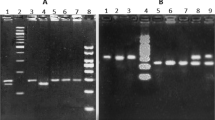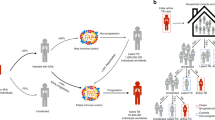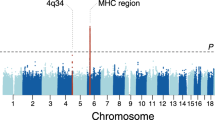Abstract
Patients (305 patients with pulmonary tuberculosis) and controls (290 household genetically unrelated contacts) were tested by polymerase chain reaction (PCR) for polymorphisms in the intron 15 and the 5′ untranslated region of the gene coding for the a3 isoform of the human ATPase gene. Diagnosis of pulmonary tuberculosis was based on chest radiography and sputum smear examination and confirmed by PCR and bacteriological tests. Alleles (two at each site) segregated in the form of four haplotype pairs: 13, 14 (very rare), 23, and 24. The 13/24 (double heterozygous) patients were protected against tuberculosis (OR: 0.15; P: 10−8; CI: 0.08–0.3). The 13/13 vs 13/24 and 23/23 vs 23/24 (double homozygous) patients were susceptible to the disease (OR. 5.8; P: 6 × 10−7; CI: 2.8–11.9; OR: 4.5; P: 5 × 10−7; CI: 2.5–8.4, respectively).
This is a preview of subscription content, access via your institution
Access options
Subscribe to this journal
Receive 6 digital issues and online access to articles
$119.00 per year
only $19.83 per issue
Buy this article
- Purchase on Springer Link
- Instant access to full article PDF
Prices may be subject to local taxes which are calculated during checkout
Similar content being viewed by others
References
Lafourcade C, Sobo K, Kieffer-Jaquinod S, Garin J, Gisou van der Goot F . Regulation of the v-ATPase along the endocytic pathway occurs through reversible subunit association and membrane localization. PLOS One 2008; 3: e2758.
Forgac M . Vacuolar ATPase: rotary proton pumps in physiology and pathophysiology. Nat Rev Mol Cell Biol 2007; 8: 917–929.
Nishi T, Forgac M . Molecular cloning and expression of three isoforms of the 100-kDa a subunit of the mouse proton-translocating ATPase. J Biol Chem 2000; 275: 6824–6830.
Sobacchi C, Frattini A, Orchard P, Porrai O, Tezcan I, Andolina M et al. The mutational spectrum of human malignant autosomal recessive osteopetrosis. Hum Mol Genet 2001; 10: 1767–1773.
Smith A, Skaug J, Choate K, Nayir A, Bakkaloghu A, Ozen S . Mutations in the ATP6N1B, encoding a new kidney vacuolar proton pump 116-kD subunit, cause recessive distal renal tubular acidosis with preserved hearing. Nat Genet 2000; 26: 71–75.
Sturgill-Koszycki S, Schlessinger P, Chakraborty P, Haddix P, Collins H, Fok A et al. Lack of acidification in Mycobacterium phagosome produced by exclusion of the vesicular proton-ATPase. Science 1994; 263: 263–268.
Singh CR, Moulton RA, Armitage LY, Bidani A, Snuggs M, Dhandayuthapani S . Processing and presentation of a mycobacterial antigen 85B epitope by murine macrophages is dependent on the phagosome acquisition of vacuolar proton ATPase and in situ activation of cathepsin D. J Immunol 2006; 177: 3250–3259.
Bidoni A, Reisner B, Haque A, Wen J, Helmer R, Tuazon D . Bacterial activity of alveolar macrophages is suppressed by V-ATPase inhibition. Lung 2000; 178: 91–104.
Trombetta ES, Ebersold M, Garret W, Pypaert M, Mellman I . Activation of lysosomal function during dendritic cell maturation. Science 2003; 299: 1400–1403.
Conboy IM, Manoli D, Mhaiskar V, Jones PP . Calcineurin and vacuolare-type H+ -ATPase modulate macrophage effector functions. Proc Natl Acad Sci USA 1999; 96: 6324–6329.
Stein CM, Nshuti L, Chiunda AB, Boom WH, Elston RC, Mugerwa RD et al. Evidence for a major gene influence on tumor necrosis factor-α expression in tuberculosis: path and segregation analysis. Hum Heredity 2005; 60: 109–118.
Flynn JL, Goldstein MM, Chan J, Triebold KJ, Pfeffer K, Lowenstein CJ et al. Tumor necrosis-alpha required in the protective immune response against Mycobacterium tuberculosis in mice. Immunity 1995; 2: 561–572.
Keane J, Gershon S, Wise RP, Mirabile-Levens E, Kaszinca J, Schwietermann WD et al. Tuberculosis associated with inflixamab, a tumor necrosis factor a-neutralizing agent. N Engl J Med 2001; 345: 1098–1104.
Ochotny N, Van Vliet A, Chan N, Yao Y, Morel M, Kartner R . Effects of human a3 and a4 mutations that result in osteopetrosis and distal renal tubular acidosis on yeast V-ATPase expression and activity. J Biol Chem 2006; 281: 26102–26111.
Green GM, Jakab G, Low R, Davis G . Defence mechanisms of the respiratory membrane. Am Rev Respir Dis 1977; 115: 479–514.
Anonymous. Freely associating. Nat Genet 1999; 22: 1–2.
Ioannidis JP, Ntzani EE, Trikalinos TA, Contoupolos-Ioannidis DG . Replication validity of genetic association studies. Nat Genet 2001; 29: 306–309.
Manly KF . Reliability of statistical associations between genes and disease. Immunogenetics 2005; 57: 549–558.
Lee WC . Searching for disease-susceptibility loci by testing for Hardy–Weinberg disequilibrium in a bank of affected individuals. Am J Epidemiol 2993; 158: 397–400.
Colhoun HM, McKeigue PM, Smith GD . Problems of reporting genetic associations with complex outcomes. Lancet 2003; 361: 865–872.
Risch NJ . Searching for genetic determinants in the new millennium. Nature 2000; 405: 847–856.
Healy DG . Case-control studies in the genomic era: a clinician's guide. Lancet Neurol 2006; 5: 701–707.
Capparelli R, Iannaccone M, Palumbo D, Medaglia C, Moscariello E, Russo A et al. Role played by human mannose-binding lectin polymorphism in pulmonary tuberculosis. J Infect Dis 2009; 199: 666–672.
Merikangas KR . Genomics revolution revolutionize psychiatry? Am J Psychiatry 2003; 160: 625–635.
Balding DJ . A tutorial on statistical methods for population association studies. Nat Rev Genet 2006; 7: 781–791.
Manolio TA, Bailey-Wilson JE, Collins FS . Genes, environment and the value of prospective cohort studies. Nat Rev Genet 2006; 7: 812–820.
Tsao H, Florez JC . Introduction to genetic association studies. J Invest Dermatol 2007; 127: 2283–2287.
Kathiresan S, Newton-Cheh C, Gerszten R . On the interpretation of genetic studies. Eur Heart J 2004; 25: 1378–1381.
Hosking L, Lumsden S, Lewis K, Yeo A, McCarthy L, Bansal A et al. Detection of genotyping errors by Hardy–Weinberg equilibrium testing. Eur J Hum Genet 2004; 12: 395–399.
Leal MS . Detection of genotyping errors and pseudo-SNPs via deviations from Hardy–Weinberg equilibrium. Genet Epidemiol 2005; 29: 204–214.
Cooke GS, Hill AV . Genetics of the susceptibility to human infectious disease. Nat Rev Genet 2001; 2: 967–977.
Mead S, Stumpf MP, Whitefield J, Beck JA, Poulter M, Campbell T et al. Balancing selection at the prion protein gene consistent with prehistoric kurulike epidemics. Science 2003; 300: 640–643.
Tishkoff S, Varkonyi R, Cahinhinan N, Argyropoulos SA, Destro-Bisol G, Drousiotou A et al. Haplotype diversity and linkage disequilibrium at human G6PD: recent origin of alleles that confer malarial resistance. Science 2001; 293: 455–462.
Bellamy R, Ruwende C, Corrah T, McAdam KP, Whittle H, Hill AV . Variation in the NRAMP1 gene and susceptibility to tuberculosis in West Africa. N Engl J Med 1998; 338: 640–644.
Schroder NW, Diterich I, Zinke A, Eckert J, Draing C, Baehr V et al. Heterozygous Arg753Gln polymorphism of human TLR-2 impairs immune activation by Borrelia burdorferi and protects from late Lyme disease. J Immunol 2005; 175: 2534–2540.
Wacholder S, Chanock S, Garcia-Closas M, El ghormli L, Rothman N . Assessing the probability that a positive report is false: an approach for molecular epidemiology studies. J Natl Cancer Inst 2004; 96: 434–442.
Antonarakis SE, Irkin SH, Cheng TC, Scott AF, Sexton JP, Trusko SP et al. beta-Thalassemia in American Blacks: novel mutations in the ‘TATA’ box and an acceptor splice site. Proc Natl Acad Sci USA 1984; 81: 1154–1158.
Koivisto UM, Palvimo JJ, Janne OA, Kontula K . A single base substitution in the proximal Sp1 site of the human low-density lipoprotein receptor promoter as a cause of heterozygous familial hypercholesterolemia. Proc Natl Acad Sci USA 1994; 91: 10526–10530.
Herzog H, Darby K, Hort YJ, Shine J . Intron 17 of the human retinoblastoma susceptibility gene encodes an actively transcribed G protein-coupled receptor gene. Genome Res 1996; 6: 858–861.
Wong-Baeza I, Gonzales-Roldan N, Ferat-Osorio E, Esquivel-Callejas N, Aduna-Vicente R, Arriaga-Pizano L et al. Triggering receptor expressed on myeloid cells (TREM-1) is regulated post-transcriptionally and its ligand is present in the sera of some septic patients. Clin Exp Immunol 2006; 145: 448–455.
Barriero LB, Neyrolles O, Babb CL, Tailleux L, Quach H, McElreavey K et al. Promoter variation in the DC-SIGN-encoding gene CD209 is associated with tuberculosis. PLoS Medicine 2006; 3: e20.
Cabrera M, Shaw MA, Sharples C, Williams H, Castes M, Convit J et al. Polymorphism in tumor necrosis factor genes associated with mucocutaneous leishmaniasis. J Exp Med 1995; 182: 1259–1264.
Jabado N, Gros P . The genetics of vulnerability. Nature 2005; 434: 709–711.
Schurr E . Is susceptibility to tuberculosis acquired or inherited? J Intern Med 2007; 261: 106–111.
Caws M, Thwaites G, Dunstan S, Hawn TR, Lan NT, Thoung TT et al. The influence of host and bacterial genotype on the development of disseminated disease with Mycobacterium tuberculosis. PLoS Pathog 2008; 4: e1000034.
Gagneux S, DeRiemer K, Van T, Kato-Maeda M, de jong BC, Narayanan S et al. Variable host-pathogen compatibility in Mycobacterium tuberculosis. Proc Natl Acad Sci USA 2006; 103: 2869–2873.
Motulski H . Intuitive Biostatistics. Oxford University Press: New York, 1995, pp 81–89.
Cavalli-Sforza LL, Bodmer WF . The Genetics of Human Populations. Freeman & Co: San Francisco, 1971, pp 39–70.
Weir BS . Genetic Data Analysis II: Methods for Discrete Population Genetic Data. Sinauer Associates: Sunderland, MA, 1996, pp 91–139.
Modiano D, Luoni G, Sirima BS, Simpore J, Verra F, Konate A et al. Haemoglobin C protects against clinical Plasmodium falciparum malaria. Nature 2001; 414: 305–308.
Miettinen OS . Proportion of disease caused or prevented by a given exposure, trait or intervention. Am J Epidemiol 1974; 99: 325–332.
Acknowledgements
We express our gratitude to the patients for participating in the study. We thank two anonymous referees for insightful comments.
Author information
Authors and Affiliations
Corresponding author
Rights and permissions
About this article
Cite this article
Capparelli, R., Palumbo, D., Iannaccone, M. et al. Human V-ATPase gene can protect or predispose the host to pulmonary tuberculosis. Genes Immun 10, 641–646 (2009). https://doi.org/10.1038/gene.2009.48
Received:
Revised:
Accepted:
Published:
Issue Date:
DOI: https://doi.org/10.1038/gene.2009.48



